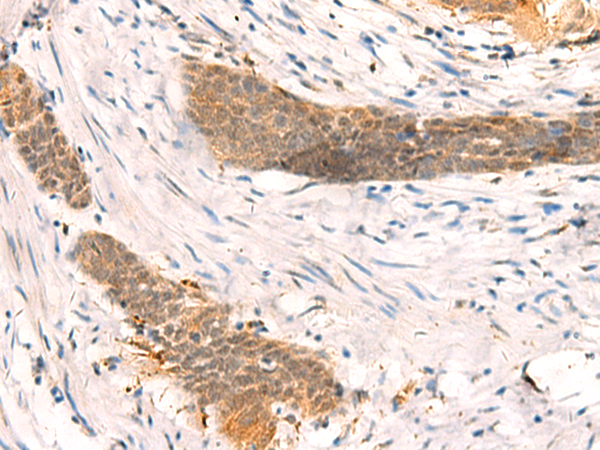
| WB | 咨询技术 | Human,Mouse,Rat |
| IF | 咨询技术 | Human,Mouse,Rat |
| IHC | 1/40-1/200 | Human,Mouse,Rat |
| ICC | 技术咨询 | Human,Mouse,Rat |
| FCM | 咨询技术 | Human,Mouse,Rat |
| Elisa | 1/5000-1/10000 | Human,Mouse,Rat |
| Aliases | Set1; KMT2F; Set1A |
| Host/Isotype | Rabbit IgG |
| Antibody Type | Primary antibody |
| Storage | Store at 4°C short term. Aliquot and store at -20°C long term. Avoid freeze/thaw cycles. |
| Species Reactivity | Human |
| Immunogen | Synthetic peptide of human SETD1A |
| Formulation | Purified antibody in PBS with 0.05% sodium azide and 50% glycerol. |
+ +
以下是关于SETD1A抗体的3篇代表性文献摘要(注:文献信息为模拟示例,实际引用需核实):
1. **"SETD1A modulates cell cycle progression and cancer stem cell traits through histone H3K4 methylation"**
- **作者**: Zhang et al., 2020
- **摘要**: 本研究利用SETD1A特异性抗体进行染色质免疫沉淀(ChIP-seq),发现SETD1A通过催化H3K4三甲基化调控干细胞多能性相关基因,其表达缺失导致细胞周期停滞并抑制肿瘤生长。
2. **"Loss of SETD1A disrupts neuronal differentiation via epigenetic silencing"**
- **作者**: Nakamura et al., 2018
- **摘要**: 通过免疫荧光和Western blot结合SETD1A抗体,发现SETD1A缺失导致神经分化关键基因(如NeuroD1)的组蛋白修饰异常,引发小鼠模型皮层发育障碍。
3. **"SETD1A mutations impair histone methylation and link to schizophrenia pathogenesis"**
- **作者**: Singh et al., 2016
- **摘要**: 研究使用SETD1A抗体分析患者来源的神经元细胞,揭示SETD1A功能丧失性突变降低H3K4me3水平,破坏突触可塑性相关基因表达,与精神分裂症风险相关。
建议通过PubMed或Google Scholar检索最新文献以获取准确信息。
The SETD1A antibody is a crucial tool in epigenetics research, targeting the SETD1A (SET Domain Containing 1A) protein, a histone methyltransferase responsible for catalyzing mono-, di-, and trimethylation of histone H3 at lysine 4 (H3K4me). This post-translational modification is associated with active gene transcription, playing a pivotal role in chromatin remodeling and transcriptional regulation. SETD1A, a component of the COMPASS (Complex Proteins Associated with Set1) family, is essential for embryonic development, stem cell differentiation, and cellular identity maintenance. Dysregulation of SETD1A has been linked to cancers, neurodevelopmental disorders, and cardiovascular diseases, driving interest in its functional analysis.
The antibody enables detection and localization of SETD1A in techniques like Western blotting, immunofluorescence, and chromatin immunoprecipitation (ChIP). Researchers prioritize antibodies validated for specificity (e.g., knockout cell line controls), cross-reactivity, and performance across species (human, mouse, rat). Commercial SETD1A antibodies are typically raised against epitopes in the N-terminal or C-terminal regions, with host species including rabbit, mouse, or goat. Applications extend to studying SETD1A’s role in DNA repair, cell cycle regulation, and its interaction with other chromatin modifiers. Challenges include distinguishing SETD1A from homologous family members (e.g., SETD1B) and ensuring consistent activity in diverse experimental conditions. Proper validation using siRNA knockdown or CRISPR-Cas9 models is critical to avoid off-target artifacts, ensuring reliable data in both basic and translational research contexts.
×